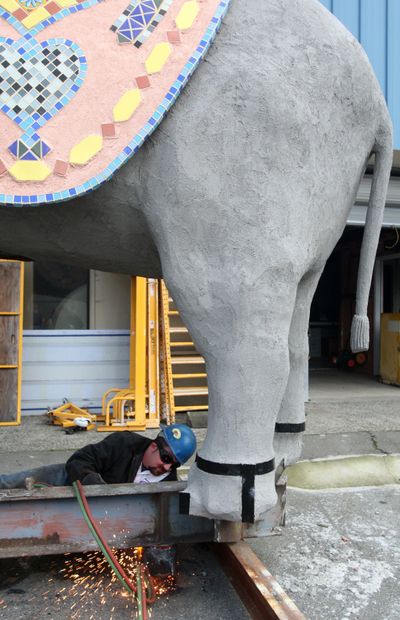Aurora elephant restored
Concrete critter is a Seattle icon

AURORA, Wash. – For a moment, as the giant concrete elephant tipped in the wind, everyone was on edge.
This day had been planned for, anticipated, canceled, then rescheduled. And Larry Steele was ready to see the job done.
As owner of a North Aurora Avenue rental store, he’d inherited this unusual icon of modern-day history when he bought the property in 2006.
The elephant, he learned, had been a roadside fixture on Aurora since the 1940s. For years, it peered down on the busy highway, hovering on steel posts above a flower-shop sign, which later became his Aurora Rents sign. At least three or four people a day stopped their cars and took pictures of it. Some, Steele said, even joked that they would lie down in front of a crane if he ever decided to get rid of it.
But time had left its mark. The elephant was missing eyes, part of its trunk and a tail. Weather had dented its hide, and generations of pigeons had lived in its hollow belly.
So Steele faced a decision: Tear down one of Seattle’s kitschiest landmarks, or spend thousands restoring it?
He chose the latter.
“The elephant has no practical use, and I should be checked for doing it, but here we are,” Steele said.
In March, Steele hired a crane operator to take down the elephant. A concrete contractor and longtime client offered to refurbish it.
Bill Heath, of W.R. Heath in Snohomish County, started working on the project last spring. “It was in pretty bad shape,” he said. “It was actually dangerous.”
The back story on the elephant goes like this: Sometime in the 1920s or ’30s, Giovanni “John” Braida, a local tile artisan, decided to build the sculpture to keep his employees busy during the Great Depression.
His idea was to create a one-of-a-kind, life-size piece to show off their craftsmanship skills, said Gil Braida, the artisan’s grandson.
Materials were scraped together from his grandfather’s backyard, Braida said. Chicken wire was stretched around a frame and reinforced with water pipes. Wet concrete was layered on top and shaped. The howdah – a decorated carriage fitted atop the animal’s back – was constructed out of wood.
After completion in the mid-1930s, the elephant stood in front of Giovanni Braida’s business at 3408 Woodland Park Ave. As the city streetcar made the bend at North 34th Street, riders looked out and recognized it as a landmark, his grandson said.
In 1946, the elephant was sold to Denny Grindall, owner of the Aurora Flower shop, for $500. Grindall and his crew loaded it on a Model-T truck and drove it to 8800 Aurora. It took Heath a few months of painstaking work to clean and restore all the elephant’s body parts, intricate tile and color.
Steele estimates the renovation cost him more than $10,000, but he hasn’t yet tallied all the receipts.
“Maybe I don’t want to know,” he said.